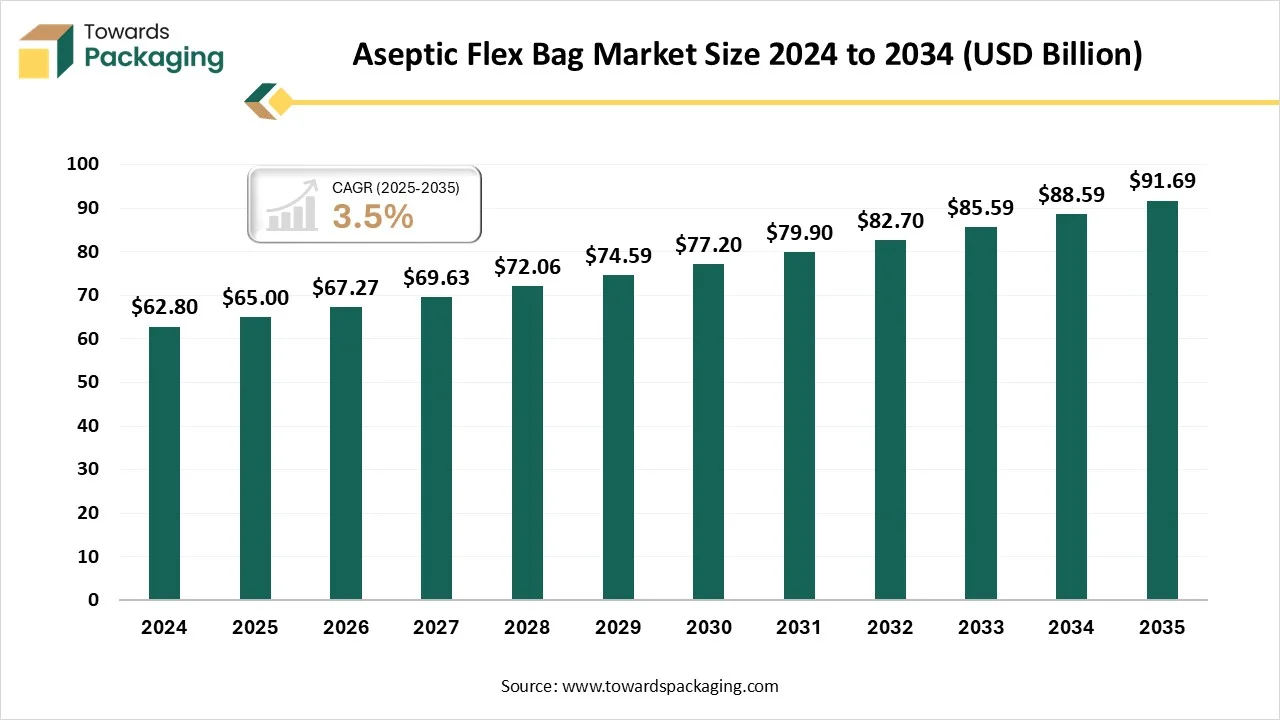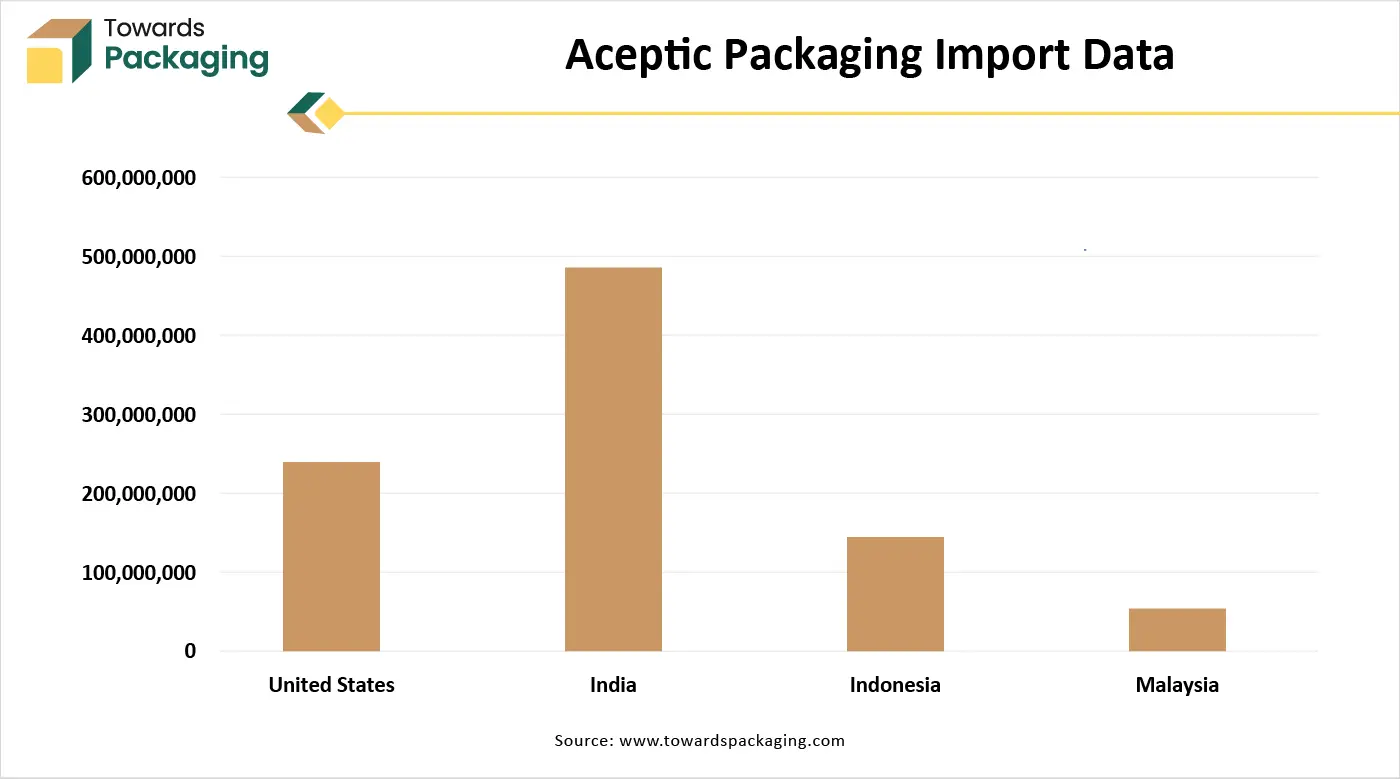November 2025
The aseptic flex bag market is forecasted to expand from USD 67.27 billion in 2026 to USD 91.69 billion by 2035, growing at a CAGR of 3.5% from 2026 to 2035.The rise in busier lifestyles and working individuals influences demand for ready-to-eat, hygienically packaged food & beverage goods that provide prolonged shelf life without refrigeration. The necessity for packing that confirms product security and durability throughout transport is important for the increasing online retail industry. Aseptic packaging is appropriate for this resolution, mainly for fragile liquid products.

The Aseptic Flex Bag comprises flexible, sterilized containers used for storing and transporting sterile liquids such as biopharmaceuticals, vaccines, culture media, and food products. These bags ensure product sterility, reduce contamination risks, and support single-use bioprocessing systems. Their demand is driven by the growing biopharmaceutical and food & beverage industries, the shift toward single-use technologies, and the need for cost-efficient, contamination-free storage and transfer solutions in aseptic manufacturing environments.
The increasing demand for enhanced sterilization process, automated filling and various such advancement has transformed the manufacturing technology of the market. The incorporation of digital monitoring throughout the manufacturing process has enhanced the integrity of the product and efficacy. This market is progressively influenced by digital alteration, with developments in automation through the value chain distribution process. Intelligent packaging process are being established to monitor food situations and freshness throughout transportation and storage.

The major raw materials utilized in this market are polyethylene, aluminum foil, EVOH, and Nylon.
The component manufacturing in this market comprises the bag material, fitments, and related machinery.
This segment ensures product integrity and sterility until they reach the consumer.
The 2D bags segment dominated the market with highest share in 2024 due to its cost-effectiveness and versatility. The increasing prevalence of diseases such as diabetes and cancer boosts the necessity for operative biopharmaceutical handlings, fuelling the demand for correlated apparatus. Enhancements in bag pattern and resources, such as improved sturdiness and puncture barrier, are making these bags more appealing to producers. A rising trend in the direction of tailored and scalable solutions permits producers to make bags for exact bioprocessing usage.
The 3D bags segment is expected to grow at the fastest CAGR during the forecast period. This segment is growing due to increasing investment in the pharmaceutical sector. They are utilized for storage a variety of goods, comprising culture and buffer media, stock resolutions, and transitional goods, mainly in the biopharmaceutical segment. The development is influenced by amplified funds in healthcare, the rising preference for throwaway bioprocessing technologies, and the growing demand for biopharmaceuticals. They show a high-development section within the wider aseptic packaging industry, which also comprises cans, cartons, and bottles.
The polyethylene segment dominated the market with highest share in 2024 due to protection against contamination and moisture barrier. This segment is influenced by demand from the food & beverage and pharmaceutical businesses, which depend on the shielding, chemical-unaffected, and non-reactive possessions of PE for prolonged shelf-life. These films are shared with other resources, like aluminum foil, to defend against moisture, oxygen, and light. This segment is essential for the disinfection procedure intricate in aseptic flex bag packaging.
The ethylene vinyl acetate segment is expected to grow at the fastest CAGR during the forecast period. This segment is growing due to increasing home healthcare services. The rising number of IV therapies and the increasing occurrence of chronic diseases are influencing the demand for this segment. The extension of home-based healthcare facilities is also an important aspect, growing the requirement for portable and easy-to-handle IV bags. Constant research and growth emphasized on enhancing the biocompatibility and medication firmness of EVA infusion bags is additionally stimulating market development.
The biopharmaceutical processing segment dominated the market with highest share in 2024 due to enhanced sterility and integrity of the products. These are important for preserving the integrity and sterility of these complex, frequently temperature-controlled, resources. This segment comprises applications such as cell therapies, sterile injectables, and reconstructed lyophilized powders, with the sector facing rapid development due to increasing medical demands, severer guidelines, and progressions in biopharmaceutical skills. Major influencer includes the necessity to protect microbial contamination and deprivation, and the growing intricacy of biologics, like gene and cell therapies, that need aseptic flex bag processing.
The food & beverage segment is expected to grow at the fastest CAGR during the forecast period. This segment is growing due to convenience and extended shelf-life. The rising worldwide demand for packaged food & beverages is a major influencer. There is a growing emphasis on sustainability in packing, and aseptic bag can support to decrease food waste by encompassing shelf-life. The demand for suitable, easy-to-eat products has amplified the usage of aseptic flex bag for on-the-go feeding.
The pharmaceutical & biotechnology companies segment dominated the market with highest share in 2024 due to continuous innovation towards sterile packaging for enhanced safety. This market comprises packaging of wide range of products such as injectables, liquid medicines, and biologics. Packaging resources must offer exceptional barrier belongings to guard against degradation and contamination. It is because of growing medical requirements, an upsurge in biopharmaceutical construction, and higher customer spending supremacy. This sector profits from trends like invention in sterilization technology, the growth of advanced resources, and an emphasis on sustainability. Corporations are also intensifying their collections to fulfil the precise requirements of the pharmaceutical & biotechnology sector.
The contract manufacturing organizations segment is expected to grow at the fastest CAGR during the forecast period. This segment is growing due to increasing demand for ready-to-administer drug formats. It is boosting the necessity for dedicated aseptic packaging bags, thus growing the dependence on CMOs. There is a rising demand for sustainable packing resolutions in the pharmaceutical sector, and incorporated CMOs are situated to influence resource invention, such as utilization recyclable resources and negligible plastics, which drive the pattern of forthcoming aseptic flex bags.
North America held the largest share in the market in 2024, due to strong pharmaceutical and healthcare industries. High economic upright permits for important venture in R&D, resulting to technologically progressive goods and advanced packaging solutions. A huge population with rising disposable earning influences demand for packed personal care products, food & beverages, all of the advantages from aseptic packing. An increasing focus on sustainability and the necessity for goods with prolonged shelf life are boosting the industry in the direction of flexible, frequently more sustainable, packing choices.
Presence of strong pharmaceutical and food & beverage industry has evolved the demand for market in the U.S. It has a cultured healthcare arrangement that boosts the demand for aseptic flex bag packaging for medical goods. The increasing emphasis on sustainability and the requirement for goods to have a prolonged shelf life are key market influencers, as aseptic flex bag packaging can decrease waste and the necessity for preservatives. A huge population with an increasing fondness for convenient, hygienic, and safe packing for ready-to-eat food products and other goods also boosts consumption.
The market is growing rapidly in Asia Pacific due to a combination of demographic and economic factors. A growing population in countries like China, Japan, India, Thailand, South Korea, and several others coupled with increasing urbanization, resulting in a larger customer base for packed products. The quick expansion of e-commerce sector in the region needs strong, safe, and lightweight packing for transport, which aseptic flex bag offer. There is a rising customer preference for suitability, one-time serve, and ready-to-consume items has increased the demand for aseptic flex bags.
Increasing disposable income among people has boosted the development process in the market in China. Customers are progressively observing goods that are good to eat and have an extended shelf life improves the need for aseptic flex bag packaging. The key drivers for aseptic flex bag are the food & beverage segments, comprising dairy, juices, and ready-to-consume products. China's robust production sector and sustained fundings in packaging invention, comprising lighter and enhanced sustainable choices, help the development of the market.
The major factors influencing the growth of aseptic flex bag market are increasing demand for sustainable and eco-friendly packaging solution. Changing customer lifestyles, considered by rising urbanization and a huge demand for suitability, influenced the requirement for ready-to-consume and on-the-go items that are easy to manage, safe, and hygienic. Strict food safety guidelines across Europe need strong, sterile packing solutions, which aseptic flex bag packaging proficiently offers. Aseptic flex bag permits pharmaceuticals, food & beverages to have an extended shelf life, which decreases food waste and lower down on cold chain logistics charges.
There is strict government guidelines towards packaging industry in Germany which fuelled the development of the market. The increasing ecological issues has raised the demand for aseptic flex bag as a sustainable option which cover a wide range of industries. Rapid growth in the manufacturing technology introduced durable and versatile packaging solution.
The market in South America is showing robust growth, driven by rising demand for shelf-stable food and beverage packaging and expansion of processing and distribution infrastructure. Key drivers include increasing consumption of processed foods and beverages, modernisation of dairy and juice production, and demand for high-barrier, lightweight packaging.
The aseptic flexbag segment in Brazil is gaining momentum. Key drivers include rising demand for shelfstable foods and beverages such as dairy, juices and ready meals, driven by shifting consumer lifestyles, increased urbanisation and greater focus on food safety. In particular, the flexibility, lighter weight and extended shelf life offered by flexbag formats appeal to both manufacturers and consumers coping with logistical challenges across Brazil’s vast geography.
The aseptic flex bag market in the Middle East & Africa (MEA) is growing steadily. Key drivers include increasing urbanisation, rising demand for shelfstable foods and beverages in hot climates, expansion of dairy and juice processing facilities (especially in countries such as Saudi Arabia and South Africa) and growth in modern retail networks.
The market in Saudi Arabia is witnessing strong growth, driven by rising demand for shelfstable food and beverages, modernised food processing infrastructure, and regulatory push for higher packaging standards. Saudi Arabia presents a favourable environment for aseptic flexbag formats (high barrier, ambient‐stable pouches) given the combination of climate (favoring ambient shelf life), growing processed food demand, and packaging infrastructure upgrades.
Amcor plc
Corporate Information
History and Background
In August 2018, Amcor acquired the U.S. packager Bemis Company, Inc. (approx. US$5.25 billion) to expand its flexible packaging business.
A major recent development: allstock combination with Berry Global Group, Inc. effective April/May 2025. This significantly broadens Amcor’s portfolio, especially in rigid and flexible consumer and healthcare packaging.
Strengths:
Weaknesses:
Opportunities:
Threats:
Recent News & Strategic Updates
Other Top Companies
By Type
By Layer Material
By Application
By End Use
Pharmaceutical & Biotechnology Companies
Contract Manufacturing Organizations
By Region
November 2025
November 2025
October 2025
October 2025